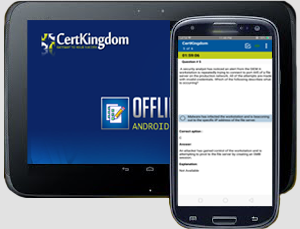Exam: PSE-SWFW-Pro-24

|
|||||||||||||||||||||||||||
Exam Code: PCNSE
Number of Questions: 75-80
Duration: 80 minutes
Format: Multiple Choice, Yes/No, Drag & Drop, Case Studies, and Multiple
Response
Passing Score: 70%
Validity: 2 years
This certification validates the knowledge, understanding, and skills required
to deploy and configure Palo Alto Networks Next-Generation Firewalls.
This certification is designed for network security engineers, systems
engineers, systems integrators, and support engineers who deploy and configure
Palo Alto Networks Next-Generation Firewalls.
Requirements
Students need to understand basic networking
Students needs to understand Networking Fundamentals
Description
Palo Alto firewalls are Next Generation firewalls built from the ground up to
address legacy firewalls issues. A great way to start the Palo Alto Networks
Certified Network Security Engineer (PCNSE PAN-OS) preparation is to begin by
properly following and understanding each topic in the syllabus. This course
follows the syllabus in the Palo Alto and describe each topic to pass the exam
the first time you take it. Also, the course concentrates on the "learn by
doing", therefore, it is a course with a lot of labs and configuration. Not just
boring Power Points presentations. This course guide is an instrument to get you
on the same page with Palo Alto and understand the nature of the Palo Alto PCNSE
exam.
The PCNSE exam should be taken by anyone who wishes to demonstrate a deep
understanding of Palo Alto Networks technologies, including customers who use
Palo Alto Networks products, value-added resellers, pre-sales system engineers,
system integrators, and support staff.
Who this course is for:
This course is for students trying to obtain the PCNSE
This course is for students trying to learn the Palo Alto Firewall
This course is for networking engineers searching to learn Palo Alto
The Palo Alto Networks Certified Network Security Engineer (PCNSE) certification
validates an individual's ability to design, deploy, configure, manage, and
troubleshoot Palo Alto Networks Next-Generation Firewalls. As of February 2025,
the PCNSE exam aligns with PAN-OS version 11.0.
Target Audience:
This certification is intended for network security engineers, systems
engineers, systems integrators, and support engineers responsible for deploying
and configuring Palo Alto Networks Next-Generation Firewalls.
Recommended Prerequisites:
Experience: 3 to 5 years in networking or security, with 6 to 12 months
focused on Palo Alto Networks Security Operating Platform.
Training Courses:
Firewall Essentials: Configuration and Management (EDU-210)
Panorama: Managing Firewalls at Scale (EDU-220)
Firewall: Troubleshooting (EDU-330)
Certifications:
Palo Alto Networks Certified Cybersecurity Apprentice
Palo Alto Networks Certified Cybersecurity Practitioner
Palo Alto Networks Certified Network Security Generalist
Preparation Resources:
Official Resources:
Palo Alto Networks TechDocs
Palo Alto Networks Cyberpedia
Palo Alto Networks Knowledge Base
Palo Alto Networks Certification Handbook
Palo Alto Networks Candidate Agreement
Training Platforms:
Palo Alto Networks' official training programs
Third-party courses such as those offered by IPSpecialist
For the most accurate and up-to-date information, refer to the official Palo
Alto Networks PCNSE certification page.
PSE-SWFW-Pro-24 Brain Dumps Exam + Online / Offline and Android Testing Engine & 4500+ other exams included
$50 - $25 (you save $25)
Buy Now
QUESTION 1
A network engineer has discovered that asymmetric routing is causing a Palo
Alto Networks firewall
to drop traffic. The network architecture cannot be changed to correct this.
Which two actions can be taken on the firewall to allow the dropped traffic
permanently? (Choose two.)
A. Navigate to Network > Zone Protection Click Add Select Packet Based Attack
Protection > TCP/IP Drop Set "Reject Non-syn-TCP" to No Set "Asymmetric Path" to
Bypass
B. > set session tcp-reject-non-syn no
C. Navigate to Network > Zone Protection Click Add Select Packet Based Attack
Protection > TCP/IP Drop Set "Reject Non-syn-TCP" to Global Set "Asymmetric
Path" to Global
D. # set deviceconfig setting session tcp-reject-non-syn no
Answer: A, D
Explanation:
QUESTION 2
A firewall engineer reviews the PAN-OS GlobalProtect application and sees
that it implicitly uses
web-browsing and depends on SSL.
When creating a new rule, what is needed to allow the application to resolve
dependencies?
A. Add SSL and web-browsing applications to the same rule.
B. Add web-browsing application to the same rule.
C. Add SSL application to the same rule.
D. SSL and web-browsing must both be explicitly allowed.
Answer: C
Explanation:
'Implicitly Uses' has web-browsing listed. This means that if you allow facebook-posting,
that it will
also be allowing the web-browsing application implicitly.. In our case, we dont
know which APP the
question referes too but 'Implicitly means already uses HTTP.
QUESTION 3
What are three tasks that cannot be configured from Panorama by using a template
stack? (Choose three.)
A. Change the firewall management IP address
B. Configure a device block list
C. Add administrator accounts
D. Rename a vsys on a multi-vsys firewall
E. Enable operational modes such as normal mode, multi-vsys mode, or FIPS-CC
mode
Answer: A, D, E
Explanation:
QUESTION 4
DRAG DROP
Match the terms to their corresponding definitions
Answer:
Explanation:
QUESTION 5
Given the following snippet of a WildFire submission log did the end-user get
access to the requested
information and why or why not?
A. Yes, because the action is set to alert
B. No, because this is an example from a defeated phishing attack
C. No, because the severity is high and the verdict is malicious.
D. Yes, because the action is set to allow.
Answer: D
QUESTION 6
Which statement is correct given the following message from the PanGPA log
on the GlobalProtect app? Failed to connect to server at port:47 67
A. The PanGPS process failed to connect to the PanGPA process on port 4767
B. The GlobalProtect app failed to connect to the GlobalProtect Portal on port
4767
C. The PanGPA process failed to connect to the PanGPS process on port 4767
D. The GlobalProtect app failed to connect to the GlobalProtect Gateway on port
4767
Answer: C
QUESTION 7
An engineer reviews high availability (HA) settings to understand a recent
HA failover event. Review the screenshot below.
Which timer determines the frequency at which the HA peers exchange messages in
the form of an ICMP (ping)
A. Hello Interval
B. Promotion Hold Time
C. Heartbeat Interval
D. Monitor Fail Hold Up Time
Answer: B
QUESTION 8
ln a security-first network, what is the recommended threshold value for
apps and threats to be dynamically updated?
A. 1 to 4 hours
B. 6 to 12 hours
C. 24 hours
D. 36 hours
Answer: B
Explanation:
Schedule content updates so that they download-and-install automatically. Then,
set a Threshold
that determines the amount of time the firewall waits before installing the
latest content. In a
security-first network, schedule a six to twelve hour threshold.
QUESTION 9
Refer to the exhibit.
Based on the screenshots above what is the correct order in which the various
rules are deployed to
firewalls inside the DATACENTER_DG device group?
A.
shared pre-rules
DATACENTER DG pre rules
rules configured locally on the firewall
shared post-rules
DATACENTER_DG post-rules
DATACENTER.DG default rules
B.
shared pre-rules
DATACENTER_DG pre-rules
rules configured locally on the firewall
shared post-rules
DATACENTER.DG post-rules
shared default rules
C.
shared pre-rules
DATACENTER_DG pre-rules
rules configured locally on the firewall
DATACENTER_DG post-rules
shared post-rules
shared default rules
D.
shared pre-rules
DATACENTER_DG pre-rules
rules configured locally on the firewall
DATACENTER_DG post-rules
shared post-rules
DATACENTER_DG default rules
A. Option A
B. Option B
C. Option C
D. Option D
Answer: A
Explanation:
QUESTION 10
A company wants to add threat prevention to the network without redesigning
the network routing.
What are two best practice deployment modes for the firewall? (Choose two.)
A. VirtualWire
B. Layer3
C. TAP
D. Layer2
Answer: AD
Explanation:
A and D are the best practice deployment modes for the firewall if the company
wants to add threat
prevention to the network without redesigning the network routing. This is
because these modes
allow the firewall to act as a transparent device that does not affect the
existing network topology or routing1.
A: VirtualWire mode allows the firewall to be inserted into any existing network
segment without
changing the IP addressing or routing of that segment2. The firewall inspects
traffic between two
interfaces that are configured as a pair, called a virtual wire. The firewall
applies security policies to
the traffic and forwards it to the same interface from which it was received2.
D: Layer 2 mode allows the firewall to act as a switch that forwards traffic
based on MAC addresses3.
The firewall inspects traffic between interfaces that are configured as Layer 2
interfaces and belong
to the same VLAN. The firewall applies security policies to the traffic and
forwards it to the
appropriate interface based on the MAC address table3.
Verified Reference:
Buy Complete
Certainly, here's a rewritten version of your text:
Packiam Vijendran 1 months ago - Malaysia
Passed the exam yesterday, 95% of the question were from this site. Note: Pay
more attention to all the community discussions on each question, instead of the
answers provided by the examtopics and I strongly suggest to get the contributor
access.
upvoted 4 times
Javier Cardaba Enjuto 2 months, 1 week ago - Spain
Excellent pre-exam session tool
upvoted 2 times
Palanisamy Arulmohan 1 months, 1 week ago - USA
I passed today, 94 questions asked and 99% of them were in this dump.
3 labs: BGP (as-override), HSRP, OSPF (without network statement)
upvoted 4 times
peppinauz 3 months, 2 weeks ago
I pass my exam, dump is valid about 90-95%. review the community answers!!
upvoted 6 times
Oberoi Ankit3 months, 3 weeks ago - USA Texas
Passed exam today dump still accurate. almost all the questions are here, some
are overcomplicated or incomplete on the site,
upvoted 4 times
logged members Can Post comments / review and take part in Discussion
Certkingdom Offline Testing Engine Simulator Download
Prepare with yourself how CertKingdom Offline Exam Simulator it is designed specifically for any exam preparation. It allows you to create, edit, and take practice tests in an environment very similar to an actual exam.
Supported Platforms: Windows-7 64bit or later - EULA | How to Install?
FAQ's: Windows-8 / Windows 10 if you face any issue kinldy uninstall and reinstall the Simulator again.
Download Offline Simulator-Beta
Certkingdom Testing Engine Features
- Certkingdom Testing Engine simulates the real exam environment.
- Interactive Testing Engine Included
- Live Web App Testing Engine
- Offline Downloadable Desktop App Testing Engine
- Testing Engine App for Android
- Testing Engine App for iPhone
- Testing Engine App for iPad
- Working with the Certkingdom Testing Engine is just like taking the real tests, except we also give you the correct answers.
- More importantly, we also give you detailed explanations to ensure you fully understand how and why the answers are correct.
Certkingdom Android Testing Engine Simulator Download
Take your learning mobile android device with all the features as desktop offline testing engine. All android devices are supported.
Supported Platforms: All Android OS EULA
Install the Android Testing Engine from google play store and download the app.ck from certkingdom website android testing engine download

Certkingdom Android Testing Engine Features
- CertKingdom Offline Android Testing Engine
- Make sure to enable Root check in Playstore
- Live Realistic practice tests
- Live Virtual test environment
- Live Practice test environment
- Mark unanswered Q&A
- Free Updates
- Save your tests results
- Re-examine the unanswered Q & A
- Make your own test scenario (settings)
- Just like the real tests: multiple choice questions
- Updated regularly, always current




